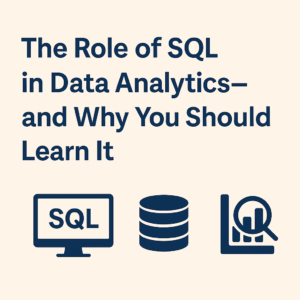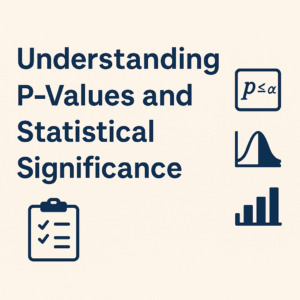Kickstart your next analytics project with this free, editable Google Sheets template. Includes every key step—from data collection to deployment—with built-in tracking.
🧠 Anatomy of a Data Analytics Project: Step-by-Step Workflow
In the world of data-driven decision-making, data analytics projects are essential for extracting actionable insights. However, success hinges not just on the tools used, but on following a structured, repeatable workflow. This blog breaks down a standard analytics project into key phases—from business understanding to actionable insights—with tools and tips at each step.
🗺️ Overview of the Data Analytics Workflow
A typical data analytics project follows this pipeline:
1. Business Understanding
2. Data Collection
3. Data Cleaning
4. Exploratory Data Analysis (EDA)
5. Feature Engineering
6. Modeling
7. Evaluation
8. Deployment
9. Communication & Reporting
1️⃣ Business Understanding
Goal: Define the problem you’re solving.
- Meet stakeholders.
- Translate business questions into analytics tasks.
- Define KPIs or success metrics.
📌 Example: “What customer attributes predict churn?”
🔧 Tools: Google Docs, Miro, Lucidchart
2️⃣ Data Collection
Goal: Gather raw data from internal and external sources.
- APIs (e.g., Google Analytics)
- Databases (SQL, NoSQL)
- Web scraping
- CSV/Excel files
🔧 Tools: Python (pandas, requests), SQL, Airbyte, Fivetran
SELECT user_id, signup_date, churn_flag FROM users WHERE signup_date >= '2023-01-01';
3️⃣ Data Cleaning
Goal: Ensure data quality—remove errors, handle missing values, correct types.
- Remove duplicates
- Handle outliers
- Impute missing values
🔧 Tools: Python (pandas, numpy), OpenRefine
df.dropna(inplace=True)
df['date'] = pd.to_datetime(df['date'])
4️⃣ Exploratory Data Analysis (EDA)
Goal: Understand data patterns, trends, and anomalies.
- Summary statistics
- Correlation matrices
- Visualizations
🔧 Tools: Python (matplotlib, seaborn), Tableau, Power BI
sns.boxplot(x='churn_flag', y='monthly_spend', data=df)
5️⃣ Feature Engineering
Goal: Create meaningful input variables to improve model performance.
- Encode categorical variables
- Create interaction terms
- Normalize/scale data
🔧 Tools: scikit-learn, Featuretools
from sklearn.preprocessing import OneHotEncoder
6️⃣ Modeling
Goal: Build and train machine learning or statistical models.
- Classification (churn, fraud)
- Regression (sales forecasting)
- Clustering (customer segmentation)
🔧 Tools: scikit-learn, XGBoost, TensorFlow, statsmodels
from sklearn.ensemble import RandomForestClassifier
model = RandomForestClassifier()
model.fit(X_train, y_train)
7️⃣ Evaluation
Goal: Measure model accuracy and business impact.
- Use metrics: accuracy, precision, recall, RMSE, AUC
- Perform cross-validation
- Conduct error analysis
🔧 Tools: scikit-learn, SHAP (explainability)
from sklearn.metrics import classification_report
print(classification_report(y_test, y_pred))
8️⃣ Deployment
Goal: Deliver results via dashboards, APIs, or embedded applications.
- Model deployment (Flask, FastAPI)
- Automated reports (Airflow, Papermill)
- Real-time monitoring
🔧 Tools: Streamlit, Dash, AWS Lambda, Vertex AI
9️⃣ Communication & Reporting
Goal: Translate insights into business language.
- Create dashboards
- Write concise summaries
- Recommend actions
🔧 Tools: PowerPoint, Tableau, Notion, Data Studio
🎯 Tip: Use storytelling—focus on the “why” and “so what.”
🧩 Real-World Example: Churn Prediction
| Step | Action |
|---|---|
| Business Question | Why are users leaving our app? |
| Data Collection | Pull 6 months of user activity logs |
| Cleaning | Drop null rows, standardize columns |
| EDA | Identify spike in churn post price hike |
| Feature Engineering | Add time-on-app, region, last activity |
| Modeling | Train Random Forest with 85% accuracy |
| Evaluation | AUC = 0.91, Precision = 0.82 |
| Deployment | Streamlit dashboard + email alerts |
| Communication | Present strategy to reduce churn by 20% |
🔚 Final Thoughts
A well-structured workflow is key to analytics success. Whether you’re working on customer insights, risk models, or operational analytics, following this roadmap will help ensure consistency, clarity, and impact.
✅ Bonus: Downloadable Template
🔽 Google Sheets Workflow Template
Here’s a 🔗 downloadable Google Sheets template that includes:
📌 Tabs Included:
- Project Overview – Goals, Stakeholders, KPIs
- Workflow Checklist – Steps from Business Understanding to Reporting
- Data Inventory – Sources, Access Details, Update Frequency
- Model Tracker – Algorithm, Accuracy, Status
- Presentation Notes – Key insights and recommendations
🧩 Use it to manage:
- Academic projects
- Client analytics tasks
- Internal team data pipelines

